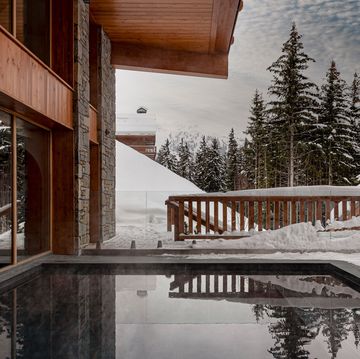Some of the world’s most thought-provoking and spirit-lifting works of art aren’t to be found in museums. Set against the beauty of nature, from the forests of Brazil to Wiltshire’s rolling hills (and even beneath the ocean’s waves), these sculpture parks offer the chance to see big ideas in the grandest of settings. Consider this your ultimate art tour, taking in every corner of the globe…
Storm King Art Center, New Windsor, New York, US
Since opening in the 1960s, this huge 500-acre site in the Hudson Valley has become an A-Z of contemporary sculpture. Originally dedicated to Hudson River School paintings (an American landscape art movement of the mid-19th century), the centre changed its focus after purchasing 13 works from the estate of sculptor David Smith, and began placing pieces within nature. Perhaps the most iconic structures to be erected here are by Chinese-born American artist Mark di Suvero, whose towering steel designs (pictured above) have an epic, agricultural quality that suits the vast landscape. Visit this year to see New York-based Swiss artists Ugo Rondinone’s The sun and the moon, grand yet delicate circles made from cast-bronze tree branches. stormking.org
Dylan Lewis Sculpture Garden, Stellenbosch, South Africa
When internationally renowned sculptor Dylan Lewis decided to level the ground at the back of his family farm to make a play area for his children, even he wouldn’t have guessed that the project would transform into what it is today. Now a seven-hectare sculpture garden containing more than 60 of his own works, it explores the Jungian notion of ‘the wildness inside’ and the concept of a judgement-free world. The possibility for the latter he sees in nature. ‘Unlike humans,’ he notes, ‘plants, birds, animals, clouds, rivers and oceans have no opinion of me; they are utterly indifferent to my existence. There is both a horror and a tremendous freedom in this realisation.’ Lewis’s works pack a powerful emotional punch as you navigate the four-kilometre path through his estate. dylanlewis.com
What's everyone reading?
Murou Art Forest, Uda, Japan
To fully experience this magical venue, the best way to arrive is to hike from Muroguchiono train station, a peaceful two-hour route beneath the pine forest’s canopy. As you approach the vast and verdant valley clearing that houses this sculpture park, the works begin to come into view. Many were created by local artist Inoue Fukichi, who hailed from the area and wanted to campaign against rural depopulation by showing, in the most unforgettable way he could, the natural beauty of this region. His mission was completed in 2006 by fellow sculptor, Tel Aviv-born Dani Karavan. Today, ten installations are dotted across this expansive garden. Karavan passed away last year, but this venue is a lasting tribute to the art and ethos of the man who became the first UNESCO Artist for Peace back in 1995. city.uda.nara.jp
Instituto Inhotim, Brumadinho, Brazil
Last year, this not-for-profit art experiment in a forest in Brazil celebrated its 15th anniversary. During those relatively short years, this venue has become home, not just to a Botanical Garden alive with more than 4,000 rare plant species, but also around 700 artworks from 40 different countries. Artists are regularly invited to Inhotim with an open remit to create works that speak to their experience of this remarkable setting. Understandably, it’s a calling that many have taken up. American artist Chris Burden’s Beam Drop Inhotim consists of 71 steel beams that burst above the treeline. Then there’s Yayoi Kusama’s Narcissus Garden Inhotim, which features 750 stainless steel balls (or ‘dots’) floated on a reflecting pool. Also worth exploring is Olafur Eliasson’s Viewing Machine, a giant in-situ kaleidoscope that will, quite literally, change your view of the world. inhotim.org.br
Chateau La Coste, Le Puy-Sainte-Réparade, France
From the moment you pass through the concrete gates, designed by Japanese architect Tadao Ando in 2011, it is clear that this is not your usual Provençal wine estate. Amid its 200 hectares of vines, which have been grown in this spot since Roman times, visitors will find permanent artworks by Louise Bourgeois (her Crouching Spider is arresting as it rises from a lake), Ai Weiwei and Tracey Emin. What’s unique here, though, is that architecture and art are given equal importance. Alongside sculptures, there are pavilions by Frank O Gehry, Kengo Kuma, Richard Rogers… the list goes on. Plus, after a guided tour, there are four excellent restaurants to choose from. The grounds also house a wellness spa and hotel. chateau-la-coste.com
New Art Centre, Salisbury, Wiltshire, UK
Since moving from its home on London’s Sloane Street to the Wiltshire countryside in 1994, New Art Centre hasn’t looked back. Taking over the house and grounds at the beautiful Roche Court, once the family home of Admiral Nelson, the gallery has expanded its mission to champion the best of up-and-coming new artistic talent. Meanwhile, it continues to honour its links to some of Britain’s most respected artists, from Antony Gormley to Edmund de Waal and David Nash. The centre also represents the Barbara Hepworth Estate, with the influential sculptor’s work to be found dotted throughout the park and the venue’s two indoor galleries – The Artist’s House and The Design House – which both aim to combine art, craft and contemporary furniture in more domestic settings. sculpture.uk.com
Museum of Underwater Sculpture, Ayia Napa, Cyprus
Not many sculpture parks require you to squeeze into a wetsuit and strap on an air tank. Those unique preparations are necessary here, though, because this venue is entirely underwater. Occupying a stretch of seabed 200 metres from the Ayia Napa coastline, the submerged park is the brainchild of sculptor Jason deCaires Taylor, whose previous works have dipped their toes into the River Thames in London (The Rising Tide in 2015), a fjord in Oslo, Norway, and the coast near Cannes, France, as well as numerous other locations. This new venue, which opened last year, is his most ambitious yet – a forest of 93 artworks submerged up to ten metres below the water’s surface. The artist is passionate about the need to rewild our oceans, and his pH-neutral sculptures are intended to be colonised by marine life, evolving as part of a reimagined natural habitat. musan.com.cy


















